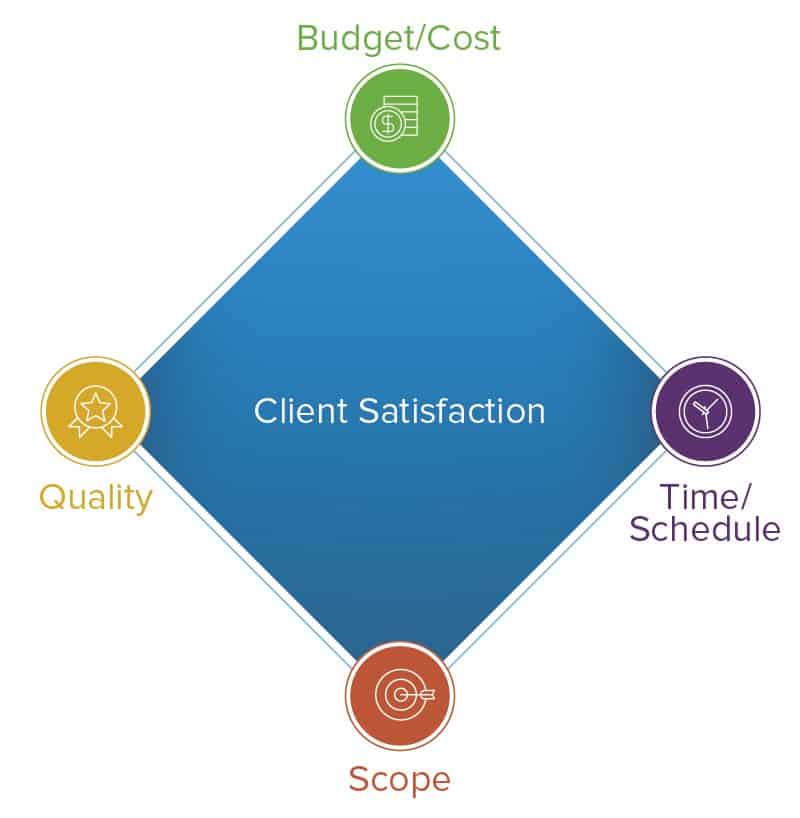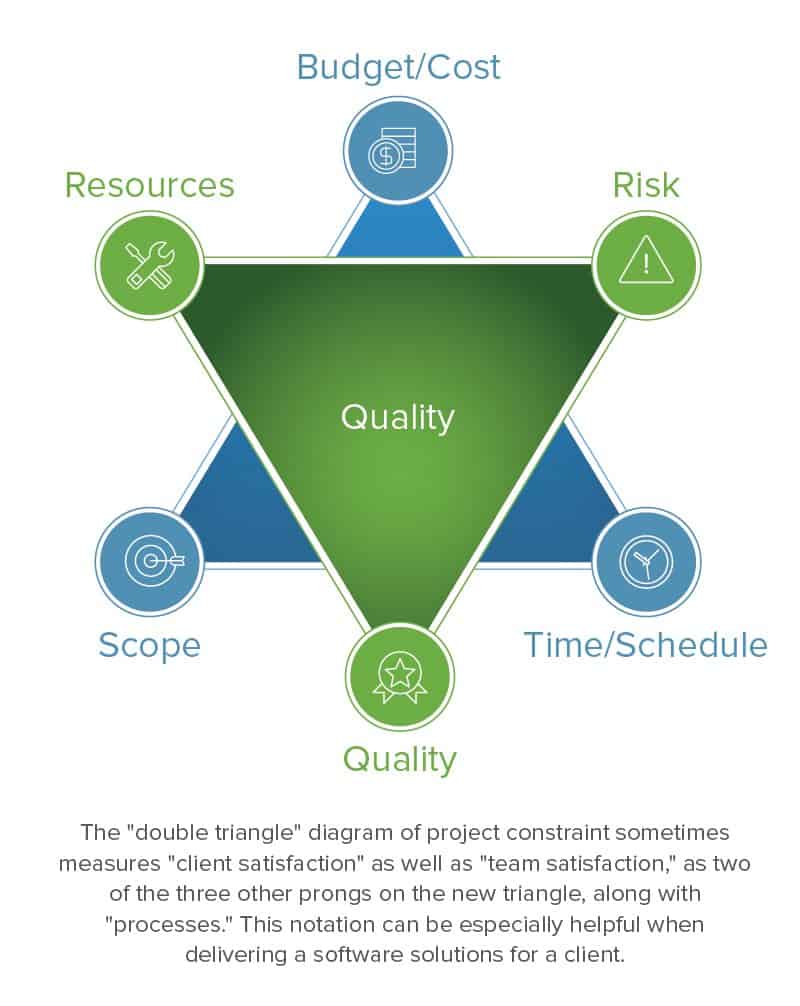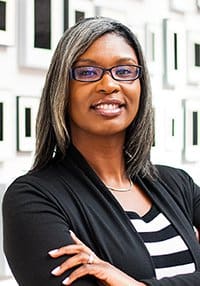What Is the Triple Constraint Triangle in Project Management?
In the modern corporate landscape, a project is typically “bound” or constrained by three elements, which may be expressed in different ways. The triple constraint theory, also called the Iron Triangle in project management, defines the three elements (and their variations) as follows:
- Scope, time, budget
- Scope, schedule, cost
- Good, fast, cheap
While the names of the three elements of the triangle may change, they all measure essentially the same thing: a fixed budget, a fixed schedule or timeline, and a fixed set of expectations or deliverables.
The triangle comes into play when something affects one of its “legs.” If that happens, you may need to adjust one or both of the other elements to accommodate the change. For example, if a client suddenly shortens a time frame, then a project will likely need more resources, or perhaps a scope reduction.
For example, let’s say that 10 people are working on creating and launching a microsite consisting of 25 web pages of copy by September 1st. The client may then realize that an important event is happening on August 15th, and decide those pages should launch two weeks earlier on the 15th. The project management constraint triangle builds can help accommodate this shortened timeline: Add more resources (in the form of more people working on the project or other resources), or limited the content for this launch - perhaps there are fewer pages, or the design is more basic.
In another case, a company may have two competing projects, but not enough staff to fully support both. A project manager may then need to move employees from the first project to the second, which affects either the scope of the first project, or the timeline, or both. In other words, a project manager can make these changes, but something’s got to give.
The concept of “quality” is sometimes introduced as another factor in the project constraint triangle, or as a fourth “leg” in what would be a project diamond. However, there are varying views on this, as quality is subjective. Does the quality of a less-in depth web page suffer, or can it still be a high-quality page with reduced scope? These are questions a project manager must always consider and keep in mind during conversations with stakeholders and clients.
Project Management Guide
Your one-stop shop for everything project management

Ready to get more out of your project management efforts? Visit our comprehensive project management guide for tips, best practices, and free resources to manage your work more effectively.
What Are the 10 Knowledge Areas of Project Management?
Another set of guidelines that project managers can find helpful when weighing the triangle for their project is the “10 knowledge areas” of project management. The Project Management Institute publishes the text, A Guide to the Project Management Body of Knowledge (PMBOK® Guide), which outlines these factors that help inform and shape the project triangle.
- Integration Management:The overarching plan of managing a project, which takes into account all schedules and process, and identifies the actual deliverables and scope of a project.
- Scope Management: This element helps focus a project’s scope, which in turn allows project managers and resource managers to plan and assign resources to it.
- Time Management: This element enables the building of processes and schedules, and ensures time frames are realistic and achievable.
- Cost Management: Performing this exercise allows you to plan a project’s overall budget, from estimating to financing to controlling costs.
- Quality Management: This element identifies everything needed to plan and produce a project that is effective and meets or exceeds the stakeholders’ goals.
- Human Resource Management: This is how team members are assigned their roles and responsibilities on a project, as well as the hierarchy of who oversees who and what.
- Communications Management: This element guides how stakeholders and project managers communicate, including the communication cadence.
- Risk Management: Identifies, analyzes, and responds to risk factors during a project.
- Procurement Management: This element applies to contractors and vendors, and all other third parties that may contribute to a project over time.
- Stakeholder Management: This element helps project managers design effective stakeholder management strategies and tools.
The Past, Present, and Future of the Project Constraint Triangle
As stated earlier, the concept of the project constraint triangle has been in use essentially since the first person hired someone else to perform a task. However, the project constraint triangle as we know it today became codified in the early to mid 20th century, in the manufacturing industry. Projects that resulted in finished products, from auto parts to children’s toys to airplanes, used the triangle during production. An airline like United might order twenty 707 jets from a manufacturer like Boeing, and the project would include a total budget, an overall timeline, and the expectation of the delivery of 20 complete, functioning planes. If United requested five more planes, the budget and timeline would shift accordingly.
In the last two decades, with the growth of software and global products, the project constraint triangle has adapted to fit these types of projects. The constraints are still present and relevant, but sometimes the concept of “scope” can be less finite than the delivery of a physical product, such as those twenty 707 jetliners. While scope and quality are still often considered together, there’s been a growing movement in digital projects to adapt the triangle to be a diamond, with four points instead of three.
In this model, quality is included as a fourth variable. On digital projects, quality and functionality can be variable and still result in a project’s success. While eliminating the hydraulic system on a plane would result in a non-functioning product, delivering a software project with less functionality than originally agreed upon could still be considered a success.
Let’s say a software company is creating an update to its mapping software. The original scope included more detailed geo-locations, interactive directions, and real-time traffic information, as well as other enhancements. As the developers work on the project, they realize that the real-time traffic functionality is going to take more time or resources to accomplish than outlined in the original brief. The decision is made to hold that functionality out of this particular deliverable to keep the rest of the updates on time and on budget; the real-time traffic feature can be rolled out in a future update.
Digital projects are continually iterative, and therefore, few things are ever considered completely “finished” in the digital world. This gives project managers and stakeholders some flexibility to keep projects moving quickly, even when they don’t deliver all the functionality initially requested - there will likely be another project that will create and deliver the missing features. In the project diamond model, “expectations” is the center and outcome of this four-sided project. If the other updates to the software release encompass enough of an improvement in functionality and ease of use, the stakeholders and end users will be satisfied. If everyone has been waiting, however, for the real-time traffic feature, the stakeholders and project managers must communicate this delay quickly and transparently, ideally with a firm new delivery date. If the outlined expectations are met or exceeded, the project is considered a success.
Some project management experts see the project triangle or diamond as not being nuanced or detailed enough to capture all the variables of a project. These experts recommend using a six-pointed star which includes components that are important, but perhaps too subjective to measure as a pillar of constraint. These include factors like risk, opinion, and value. The current thinking of the Project Management Institute and other experts is that they commend these six-pointed stars for trying to capture these important influences, but that it makes managing a typical project too complex and ultimately too cumbersome. Instead, project manager should continually weigh these other factors as a project progresses over time.
Why the Triple Constraint Is Important for Project Success
Every project needs guardrails. Even on a basic level, these guardrails are all concepts everyone should be able to agree upon before the first day of any project. The triangle provides a clear way to signal to stakeholders scope creep. It also demonstrates what tradeoffs can and should be weighed and made. The triangle model also empowers project managers to measure external factors and forces and their effect on one or more “legs.”
This dashboard can help project managers track the schedule, budget, and scope of their projects, and can be adapted to meet the needs of almost any project. Keeping the project triangle in mind can help project managers and supervisors raise an alert before a project is adversely impacted. To be useful, a dashboard must measure the three factors that can be regulated to deliver the best quality in a project.
The Opposing View: Why Some Think the Triple Constraint Model Doesn’t Work
Some business experts think the triple constraint model may have been useful for a business landscape focused on creating physical products, but is less relevant now in the digital world. In his research paper, project management expert Wei Lee states that the triangle is too simplistic in today’s more complex landscape. He points out that increasingly, issues that can affect a project are in fact outside of a project manager’s control - making it nearly impossible to actually manage a project’s demands and influences.
John Ferguson Smart, an author and expert in digital project management, agrees. Smart believes that the triangle was and can be valid in a manufacturing setting, but is irrelevant in software development, medicine, and other more complex fields. Adding 12 more heart surgeons to an operating room, he writes, won’t speed up a heart transplant operation, or ensure that the outcome is any better for the patient. Instead, Smart recommends higher-level concepts such as investment, return on investment (ROI), and cost of delay.
In the end, of course, all projects and project managers are seeking the same thing: A happy client and a positive outcome for the project. In many instances, the project constraint triangle is still quite relevant and useful.
5 Steps to Create a Useful, Tailored Constraint Analysis for Your Project
When starting a project, it might help to sketch out a triangle with what you know for each “leg.” However, these steps, mentioned in varying ways by different project management experts, may be more useful in identifying what you need to set up for success:
Step 1: Identify the constraint(s), which include (but aren’t limited to) the policies or resources that could prevent the successful execution of your project.
Step 2: Decide how you’ll most effectively adapt and use the constraint and its elements.
Step 3: Make sure all other project and organizational processes comply with and support steps one and two.
Step 4: Raise the constraint if needed, but do so in concert with the other two constraints. Where you start may not be where you finish, but each factor should still be relevant and managed.
Step 5: As you identify the constraints and realize something has moved or is no longer relevant, return to step one.
In addition to these steps, the PERT principles can be business-critical in creating accurate budgets and timeframes, and dovetail perfectly with the creation of a triple constraint project management triangle.
Triple Constraint: The Experts’ Views
Alma Miller, PMP, is CEO of AC Miller Consulting in Maryland and is on the business faculty of Johns Hopkins University. She believes the triple constraint triangle is still relevant in today’s business environment. “People are more flexible now and more inclined to compromise to get a project done,” Miller says. “Unfortunately, the easiest place to compromise is in quality.”
That may not matter as much - for instance, “If you are delivering an update to, say, the game Candy Crush Saga,” says Miller. “But if you are delivering a security system to the federal government, that is an area that should absolutely not be compromised.”
She adds, “It’s important to be realistic. Some clients may have tons of money, but that won’t necessarily make the timeline shorter. This is where a project manager should come in with realistic proposals and alternatives. Here is what we agreed to, in our scope of work, and if we modify the budget in this way, that will affect the scope and the timeline in these other ways.”
Roman Rittmann is the Director of Demand Generation at Hackerbay in Berlin, Germany. He says that in general, the project triangle can be helpful as a very loose snapshot of investment vs. output. “In software, it’s not just the clients who are invested in the scope or quality.” Developers and contractors who work on software projects for his company, Rittmann explains, are as focused on quality, functionality, and scope as the clients. “They are driven to work until the quality is where they want it to be. Many of them will take less money to have higher quality. This goal is really what drives many of them.”
Sometimes clients don’t even know how they would measure quality or scope or outcome in a project that they hire Hackerbay to work on and create, Rittmann says. The company’s expertise and commitment to results mean that even a pushed timeline or scope creep might be something the company would take on as a cost of doing business to prevent them from delivering anything short of a stellar product.
Both Miller and Rittmann say it’s critical to build in the ability to pivot with change - meaning that a project manager may revisit the constraints often (sometimes daily) to tweak expectations as necessary. Both experts acknowledge that the concept of quality will always be subjective. In the case of updates to the software of a game, “good enough” will be good enough. In the case of updates to national security systems, “good enough” is not good enough, and that project will be up to par only when it meets or exceeds every aspect of the project plan.
Support Your Triple Constraint Project Triangle with Smartsheet for Project Management
Empower your people to go above and beyond with a flexible platform designed to match the needs of your team — and adapt as those needs change.
The Smartsheet platform makes it easy to plan, capture, manage, and report on work from anywhere, helping your team be more effective and get more done. Report on key metrics and get real-time visibility into work as it happens with roll-up reports, dashboards, and automated workflows built to keep your team connected and informed.
When teams have clarity into the work getting done, there’s no telling how much more they can accomplish in the same amount of time. Try Smartsheet for free, today.





